Art / Sculpture
Sculpture related newsitems
-
-

The history of Cuba Mall and its Bucket Fountain
- Wellington City Council
- The summer of 1969 in Wellington brought a pedestrianised mall, and the erection of the Cuba Mall water mobile, or as we know it, the Bucket Fountain.
- Accepted from WCC news HTTPS by feedreader
- Tagged as:
- bucket-fountain
- local-history
-
-
-
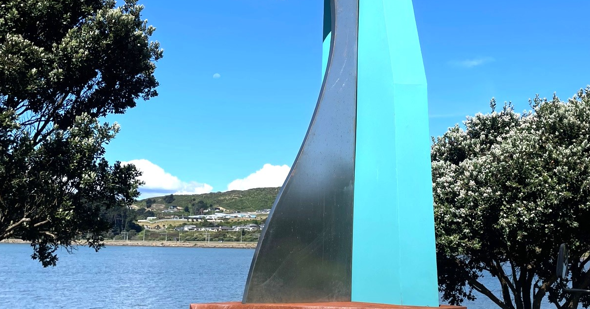
Sculpture repaired after vandalism
- Porirua City Council
- A sculpture on Porirua's Writer's Walk has been repaired after being vandalised.
- Accepted from PCC Latest news items by feedreader
- Tagged as:
- porirua
- sculpture
Wi Neera Drive, Takapūwāhia, Porirua, Porirua City, Wellington, 5022, New Zealand (OpenStreetMap)
-
-
-
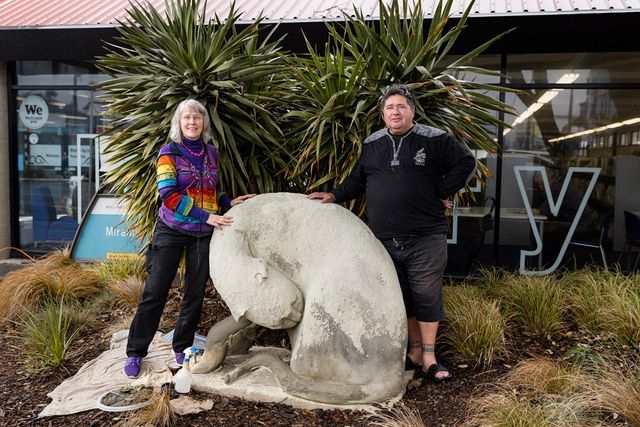
Artists collaborate to bring cat sculpture up to scratch
- Wellington City Council
- A popular sculpture outside Miramar Library is getting a much-needed repair job thanks to a collaboration between the original artists’ son and a local artist.
- Accepted from WCC news HTTPS by feedreader
- Tagged as:
- miramar
- libraries
- sculpture
Miramar Library, 68, Miramar Avenue, Miramar, Wellington, Wellington City, Wellington, 6242, New Zealand (OpenStreetMap)
-
-
-
Wellington has a HALO !
- Friends of Te Papa
- To celebrate 40 years of enhancing Wellington through public art, the Wellington Sculpture Trust has gifted a virtual monument to the city. The work HALO by Gill Gatfield, is a […]
- Accepted from News – Friends of Te Papa by tonytw1
- Tagged as:
- sculpture
-
-
-
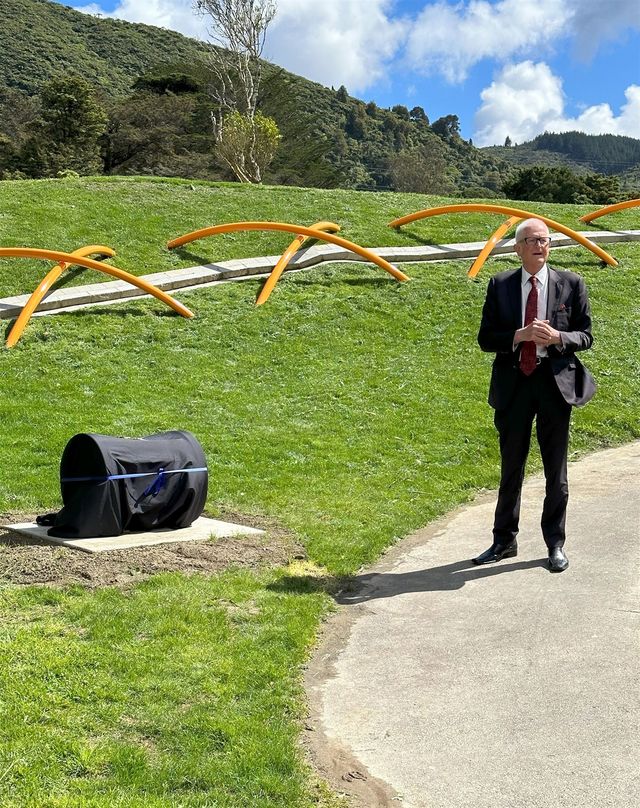
New Forces of Nature sculpture ‘sews together’ surroundings
- Upper Hutt City Council
- A new sculpture which ‘sews together’ the fault scarp at Harcourt Park was unveiled by Upper Hutt Mayor Wayne Guppy on Friday morning.
- Accepted from Upper Hutt City news 2021 by feedreader
- Tagged as:
- upper-hutt
- sculpture
Harcourt Park, Brown Owl, Upper Hutt, Upper Hutt City, Wellington, New Zealand (OpenStreetMap)
-
-
-
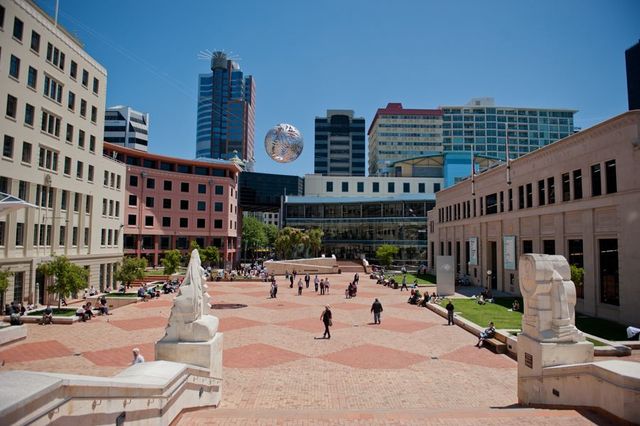
Forty years of public art in the capital
- Wellington City Council
- From Len Lye’s water whirler, to the Zephyrometer (orange needle) on Cobham drive, to the silver fern ball in Te Ngākau square – public art has become a key part of Wellington’s identity. But where did these works come from?
- Accepted from WCC news HTTPS by feedreader
- Tagged as:
- cobham-drive-crossing
- sculpture
Cobham Drive, Kilbirnie, Wellington, Wellington City, Wellington, 6021, New Zealand (OpenStreetMap)
-
-
-
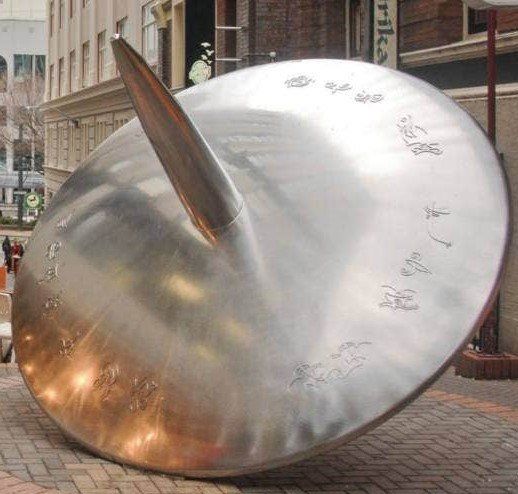
Wondering what this inner-city sculpture means? Here's the story
- INNER-CITY WELLINGTON
- From Stuff The story behind Robert Jahnke's Spinning Top off Wellington's Golden Mile This year is the Wellington Sculpture Trust's 40th anniversary. To celebrate this, The Dominion Post is spotlighting sculptures the trust has helped bring to life. This week Sue Elliott takes a look at Robert Jahnke’s Spinning Top. Read the full Stuff article here
- Accepted from News - ICW by tonytw1
- Tagged as:
- sculpture
Spinning Top, Woodward Street, Paekākā, Wellington Central, Wellington, Wellington City, Wellington, 6145, New Zealand (OpenStreetMap)
-
-
-
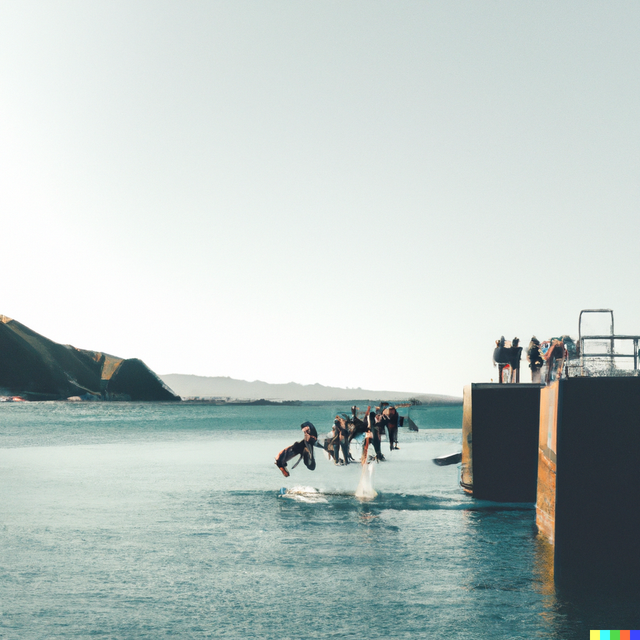
We ask AI to take us on a tour of Wellington – it was weird
- Capital Magazine
- We asked an AI image generator to show us Wellington – here’s how it got on.
- Accepted from Capital Magazine by tonytw1
- Tagged as:
- bucket-fountain
- photography
-
-
-
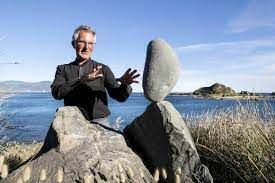
Stavros’s Sculptures
- Island Bay Residents' Association
- ‘Stavros Kyriakides has been an Island Bay local for 47 years, and is known for his delicately placed stone artworks along the South Coast. He began in 2013, after a storm washed up piles of logs onto the sand. Over the years, he’s moved away from using wood and turned instead to stone, balancing largeContinue reading "Stavros’s Sculptures"
- Accepted from Island Bay Residents' Association feed by feedreader
- Tagged as:
- island-bay
- sculpture
Island Bay, Wellington, Wellington City, Wellington, New Zealand/Aotearoa (OpenStreetMap)
-
-
-
PARK(ING) DAY 2022Wellington Sculpture Trust | News
- Wellington Sculpture Trust
- Friday 4 March is Wellington's PARK(ing) Day! Providing temporary public open space—one parking spot at a time! For one day a year, artists and community groups take over inner-city car parks, challenging us to think about how we can make better use of our public space. Take a walk down Cuba Street between 9am and 5pm for a surreal outdoor art experience!
- Submitted by tonytw1
- Automatically tagged as:
- sculpture
-
-
-

Wellington Sculpture Trust - looking for PARK(ing) Day 2022 submissions - closes 31 Jan 2022
- INNER-CITY WELLINGTON
- From Wellington Sculpture Trust website: We are excited to announce that we've opened our call for proposals for PARK(ing) Day 2022! Submissions are due on 31 January 2022, with PARK(ing) Day itself scheduled for Friday 4 March.
- Accepted from News - ICW by tonytw1
- Tagged as:
- sculpture
-
-
-

Plimmerton Farm: getting greenfields right
- Talk Wellington
- If we’re hellbent on doing more residential development in greenfields, what does “decent” look like in Plimmerton, hilly land near an existing suburb – like most of our region’s greenfields? This post is basically a guide for anyone who cares about Plimmerton, good urban development, or healthy wetlands, streams and coast, but is time-poor and can’t face going through the truckloads of documents they’ve stuck up without any specific meta-guidance (some FAQ are here). Hopefully this will help you pop in a submission! PCC’s “information” pages they suggest you use for submitting. Every one of these is a large PDF document, 90% written in technical language… aargh! The background: what where and how For those who don’t know, Plimmerton Farm’s a big proposed subdivision of hilly farmland draining into the significant Taupō Wetland and to Plimmerton Beach, just over the train line and highway from Plimmerton village (original Ngāti Toa name: Taupō). It’s going through a Streamlined Planning Process, a pre-COVID government scheme for accelerating development. The key step is the requisite change of the land’s zoning in the Porirua District Plan (“rural” zone to “residential” and other “urban” zones) that sets out what kind of stuff can then be built, where. It’s mostly streamlined because there’s just one shot for the public to have input on the plan change. One shot. Why submit? I was born and raised in Plimmerton, live here now, and intend to for the rest of my days. I’d love to see it grow, well. I would love Plimmerton to get more wallets, more hearts and minds, more faces (more diverse ones too!). But not with more traffic, and pointless damage to our environment. Right now, the proposal has some serious flaws which need sorting. I say Sorting because the changes won’t make it crazy innovative, just good enough for a development in the spot it is, being kicked off in 2020. Time matters too: there’a a bunch of good things happening imminently (and some bad Porirua trends that need to be reversed). I cover these in Get it right, below. It’s worth submitting because given the situation, a 1990s-grade development just won’t cut it. So what about Plimmerton Farm needs to change? It boils down to two themes: dial down the driveability and dial up the liveabilitymake Local the logical and easy choice for daily needs I’ll outline what needs to change in each. NOTE: There’s a third – don’t stuff the wetlands and streams. This is really important as Taupō Wetland is regionally significant, and all our streams and harbours have suffered from frankly shameful mismanagement of sediment from earthworks-heavy subdivisions like Aotea and Duck Creek, and from the earthworks-a-rama of Transmission Gully. Friends of Taupo Swamp have an excellent submission guide for you – add in some of their suggested bits to your submission. I: Dial down the driveability, dial up the liveability There aren’t many truly black-and-white things in life, but there’s one for towns: If a street is nice to drive in, it’ll be a crappy place to do anything else in (walk / eat / hang out / have a conversation / play / scoot or cycle / shop / have a pint). If it’s nice to do anything else in, it’ll be a crappy place to drive in. Mostly this is because of the nature of the automobile: big solid things that smash into our soft bodies if someone makes a mistake (75% odds of death if that’s at 50km/hour, 10% odds of death if at 30km/hour) big objects that need lots of space for manoeuvering and especially parking – which offstreet can be crazy expensive and push up the cost of a home, and onstreet hoover up valuable public space. big solid things driven by us real humans (for a while at least) who respond to the environment but also get distracted, and generally aren’t good at wielding these big solid things safely. The transport setup proposed for Plimmerton Farm makes for a much too driveable and poorly liveable place. 1. Narrow down all the roads. The current proposal’s roading setup has roads and streets that are too big, and there’s too much of them. Right sized roads for a liveable community The cross-sections for the roads include on-street parking and really wide lane widths. This is really gobsmacking for a consortium that talked a big talk about good practice. For all the reasons that Low Traffic Neighbourhoods are good, this is bad. (And it’s especially nuts when you realise that the excessively wide “arterial” roads (11 metres!) will need earthworked platforms built for them where they’re drawn running up the sharp ridges and across the tops of gullies. Expensive, damaging for the environment, and … what were they thinking?) So recommended changes: NARROW DOWN THE ROADS. Seriously. Design all the living-area streets and roads, and the centre, to be self-explaining for an operating traffic speed of 30km or less – that’s the speed where mistakes are rarely fatal. What does that look like? The designers will know and if they don’t they should be fired. Narrower crossing distances; chicanes (great way to incorporate green infrastructure and trees and seating!); narrowed sight-lines (trees! sculpture!) so no-one driving feels inclined to zoom. Reduced trafficked lanes (rori iti on the larger roads!), with properly wide and friendly footpaths. Threshold treatments, humps, modal filters, all the things we know very well are the natural ways to slow us down when driving, and make streets nicer for people. The beauty of all this “restriction” on driving is how much it frees us up for making everything else appealing. Streets become hospitable for kids to walk, scoot, bike to school safely, using the road not the footpath. Older people and those with impairments can walk and wheelchair safely. Teens coming home from town of an evening can scoot or bike home, safely. Popping down to the shops or for a coffee or to the train becomes a pleasure to do on foot, or on a scooter or bike. And you’re moving in a legitimate way – seeing and being seen, not stuck off in the bush on a “recreational” track like what they’ve described. The ordinary streets and roads are walkable, bikeable, scootable, mobility-scootable, and perfectly driveable, equally safe and useable in all weathers and anytime of day or night. Used to be a big, fast road. Now, kids bike to school and old people can chill out on it. (Mark Kerrison) (And in case you’re worried about firetrucks / rubbish trucks / buses, recall that on even Wellington City’s far more winding, narrower hilly streets everyone gets their rubbish collected and fires fought just fine. On public transport, smaller buses, like those that community transport operators use, are the way of the future for less densely-populated areas like this). Don’t build the through and loop roads. You don’t need signs like this when the only people who bother to drive in are those who live there, or who are visiting friends, because you just have to drive out again the way you came. When it’s the place you live, you’re invested in not being a dick far more than if you’re just out for a drive – or worse, out for a bit of a boyrace hoon on a massive loop route through a whole place. So just don’t build those big connector roads that enable people to drive easily from one residential area to the next, especially the ones up in the hilltops (section C) that just say “come for a hoon!” Instead, connect the living spaces heavily with bikeable, walkable, scootable, disability-friendly streets and lanes, and as much as possible, only one way in and out for cars from each living area. II: Make local logical and easy Plimmerton is a true village, with a great little centre (including a train station!) but Plimmerton Farm is ultimately a damn big area. The way to go is to enable people to get the basics of life – like school, groceries, a coffee – with a little local trip on foot, bike or scooter – it’s more of a bother to get in the car. Right now though, it needs two changes: 1. Provide for a second centre “Bumping into” spaces are known to be crucial to a feeling of neighbourhood, and in the (initial) absence of third places (worship places, community hall, sports club, cafe/pub, a supermarket is a vital social centre. Yet the north end of Plimmerton Farm is currently a deadzone for anything except residential. What things will probably look like under current layout. Like in Edwards Scissorhands without the interest of a castle. There’s no provision for a place to do your household groceries, so people will drive to Mana New World – more car trips – and less opportunity to bump into people who live nearby. (There’ll be no school in Plimmerton Farm for a while, because Ministry of Education isn’t allowed by the Education Act to build a school somewhere until there’s a certain population density of kids to fill it. A shitty Catch-22 for developments which is hopefully going to be fixed … sometime. Just another reason to make walking, biking and scooting really kid-friendly, as extra dropoff traffic for kids going to St Theresa’s, Plimmerton School, Paremata and Pukerua Bay schools will be a nightmare.) So they should provide for an additional centre in the north, including a groceries place of some kind. 2. Intensify within walking distance of Plimmerton proper. We should intensify properly, with lots of medium and even some high density (6 storeys of nicely laid-out density done well!) in the area that’s within a 5-minute walk of Plimmerton Village. The more people can live and work with access to all its many amenities, and its rail station (10 min to Porirua, 30 min to Wellington), the better. But there’s not enough density provided for there. Plimmerton Railway station: buzzing in 1916 and has only got bigger. (Photo: Pātaka Porirua Museum) So they should add another zone – E – of higher density in that 5-minute walking catchment of Plimmerton Village. What could it look like? A good example is 3333 Main, Vancouver . Submission tips On the site they ask you to fill in a Word or PDF form, saying which specific bit of the gazillion proposals you are talking about and the specific changes you want. This is a BS way to treat the vast majority of people submitting: normal non-professionals, just regular people who care about good development and liveable places. So just don’t worry about that. In those question 6 column boxes just put “Transport” and “Layout”. It’s the professional planners’ job to figure out specifically how to change a planning document. Just be specific enough that they know what you want to see. The text above is worth copying and pasting – it’ll be enough. And don’t forget the Friends of Taupo Swamp and Catchment advice is essential – definitely go read and use. That’s all you really need – just go submit! But if you’re keen to know more reasons why they should be doing this better, here’s some… Get it right, now Once this plan change is through, traditional developers like Gillies like to whack in all the infrastructure – hello, massive earthworks. And yet the place will take decades to fill with actual people – those hearts and minds and wallets. (Note even before COVID, Porirua’s growth rate was 0.1% per year. Yep, one tenth of one percent.) And extra pressure’s on to do this better because all these things are features of the next one to three years: the One Network Road Classification (sets the design specs for roads of different types) is being updated right now to be more people-friendly in the specs for roads in residential and centre areas, so designs like Plimmerton Farm’s will soon be Officially Bad Practice Sales and riding of e-bikes and e-scooters are going through the roof, continuing through and beyond COVID – this shows no signs of slowing, and prices are dropping. E-power flattens the hills of Plimmerton Farm and makes wheely active travel a breeze for the middle-class people who’ll be living here, if the streets and roads are hospitablePlimmerton Railway Station (on the most popular Wellington train line) is being upgraded to be a terminus station – i.e. better servicesThe Wellington Regional Growth Framework is setting a bunch of directions for councils on how to grow well, including well-known but often well-ignored issues like intensifying around public transport hubs Councils will soon be required to do to a bunch of a bunch of international good practice including get rid of many minimum parking requirements (in the news lately), and to upzone (enable intensification) of landuse in the walking catchment of public transport hubs. (5 min walk = approx 400 metres, 10 min = 800m).Bad trends we need to stop: Porirua’s really high car-dependency (we own cars a lot and drive a lot) is continuing, due to car-dependent urban form [PDF]– despite nice words in council’s strategic intentions.People living outside Wellington City are mostly to blame for our region’s 14% increase in emissions from transport in just 10 years. OK go submit now – and share with anyone who you think might care!
- Accepted from Talk Wellington posts by feedreader
- Tagged as:
- paremata
- porirua
- transmission-gully
- sculpture
- government
- parking
- design
- covid-19
- law
- planning
- wellington
- education
- developments
- sport
- buses
- coffee
- zoo
- people
Wellington Zoological Gardens, Manchester Street, Melrose, Wellington, Wellington Region, 6021, New Zealand (OpenStreetMap)
-
-
-
Wellington High School students pitch ideas to Council
- Worser Bay Boating Club
- Wellington High School students have pitched a set of ideas to Wellington's Mayor and Councillors for development under the banner of Waka Tuaone. They have identified eight projects they want to work on ranging from underwater sculpture trails to paua nurseries. Check out their presentation here
- Accepted from WBBC blog by feedreader
- Tagged as:
- councillors
- sculpture
- water
- wellington
Worser Bay Yacht Club, Marine Parade, Seatoun, Wellington, Wellington City, Wellington, New Zealand (OpenStreetMap)
-
-
-
August 2014: 4 Plinths 5 call for proposals
- Wellington Sculpture Trust
- The four plinths are the massive bollards situated on the waterfront between Te Papa and Circa Theatre. It is on this site that the Wellington Sculpture Trust showcases New Zealand sculptural practice with the biennial temporary sculpture installation: the 4 Plinths Sculpture Award. The chosen sculpture will form part of the New Zealand International Arts Festival’s visual arts programme and remain in place outside Te Papa for up to two years.
- Accepted from WST news
- Automatically tagged as:
- sculpture
-
-
-
March 2014: Melbourne Studio Visits and MONA
- Wellington Sculpture Trust
- With much anticipation, the travellers, some bright-eyed, others weary and bleary-eyed, met at Wellington Airport to check-in for a 6.20 a.m. flight to Melbourne. Thus began a wonderful adventure to the art world of Melbourne and Hobart.
- Accepted from WST news
- Automatically tagged as:
- sculpture
-
-
-
20 Feb 2014: Fourth Four Plinths Sculpture launched
- Wellington Sculpture Trust
- Glen Hayward’s Rita Angus grew her own vegetables was launched by the Mayor of Wellington at a function on site by the national museum Te Papa on the evening of 19 February2014 before a crowd of about seventy persons. Other speakers were the Chair of the Wellington Sculpture Trust Sue Elliott, and the sculptor Glen Hayward.
- Accepted from WST news
- Automatically tagged as:
- sculpture
-
-
-
19 Feb 2014: New Four plinths installation
- Wellington Sculpture Trust
- Installation commenced on Monday 17 February 2014 of a dramatic new public art work on Wellington’s Waterfront. Named Rita Angus used to grow her own vegetables, the work comprises four large-scale replicas of shards of pottery found by the artist, the eminent New Zealand sculptor Glen Hayward, while on a residency in the Rita Angus cottage in Thorndon.
- Accepted from WST news
- Automatically tagged as:
- sculpture
-
-
-
September 16: PARK(ing) Day Friday 20 September
- Wellington Sculpture Trust
- PARK(ing) Day, Wellington, is this Friday the 20th September, 8am - 8pm. There will be 18 installations over 23 parks in the central CBD. There are a mixture of PARKs - music, native trees & bird sounds, kinetic machines, recycled and upcycled installs, a Box Office and many more. Have a look at the map below to see where all the PARKs will be located.
- Accepted from WST news
- Automatically tagged as:
- sculpture
-
-
-
Wellington Park(ing) Day
- Wellington Sculpture Trust
- Providing temporary public open space . . . one parking spot at a time. CALL FOR EXPRESSIONS OF INTEREST This year the Wellington Sculpture Trust, in association with the Wellington City Council, are organising a Wellington version of PARK(ing) Day and are seeking submissions from people or groups who would like to take over an inner city car park for one day.
- Accepted from WST news
- Tagged as:
- parking
-
-
-
Annual Public Review
- Wellington Sculpture Trust
- Tomorrow night, 16 July, we have our annual public review, where we will give an overview of the activities of the Trust from the last year as well as a special presentation by Associate Professor Dr David Cross: SEMI PERMANENT: DOES PUBLIC SCULPTURE HAVE A USE BY DATE?
- Accepted from WST news
- Automatically tagged as:
- sculpture
-
-
-
June 2013: Glen Hayward selected to make forth iteration of the Four Plinths
- Wellington Sculpture Trust
- Glen Hayward selected for the forth round of the Four Plinths Temporary Sculpture project Glen Hayward's Rita Angus used to grow her own vegetables was selected by the Trustees and our Arts Advisors for the fourth iteration of the Four Plinths Temporary Sculpture Project. His work will be unveiled in February 2014 during the International Festival of the Arts and will remain in place for two years. You can view Glen's exhibition I don't want you to worry about me, I have met some Beautiful People in the North gallery of the City Gallery, Wellington at the moment.
- Accepted from WST news
- Automatically tagged as:
- sculpture
-
-
-
Nga Kina wins people's choice award
- Wellington Sculpture Trust
- Nga Kina wins Peoples Choice at the Civic Trust Awards On 21 May at a ceremony at the Wellington City Council chambers Michel Tuffery's Nga Kina won the Art in the City - peoples choice award. Michel, his wife Jayne and their two children were there to collect the award, as well as Sculpture Trust Chair Sue Elliott. The awards were sponsored by the Museum Art Hotel and the owner Chris Parkin announced the winners.
- Accepted from WST news
- Automatically tagged as:
- sculpture
-
-
-
Woman of Words unveiled
- Wellington Sculpture Trust
- Woman of Words unveiled The Katherine Mansfield commemorative sculpture Woman of Words by prominent New Zealand sculptor Virginia King was unveiled by Wellington’s Mayor Her Worship Celia Wade-Brown in an evening function at the site on the Corner of Waring Tayor St and Lambton Quay outside Midland Park.
- Accepted from WST news
- Automatically tagged as:
- sculpture
Midland Park, Lambton Quay, Wellington Central, Wellington, 6012, New Zealand/Aotearoa
-
-
-
October 2012: Trust’s sculptures valued at $7.5 million
- Wellington Sculpture Trust
- Extract from an address to the Joint Annual Dinner of the Karori Rotary and Lions Clubs, 31 October 2012 by Neil Plimmer, Chairman of the Wellington Sculpture Trust. “We get much favourable feedback from the public about the 25 sculptures that we have provided for Wellington over our lifetime, but the proof that holds the most sway is that Wellingtonians keep funding them. We thrive on the support and benefaction of the people of Wellington. “The total cost of the 25 sculptures is $4.5 million which inflation-adjusted yields about $7.5 million. The overwhelming bulk of this is raised privately, from companies, family trusts, individuals, grant-giving bodies and other sources.
- Accepted from WST news
- Automatically tagged as:
- sculpture
-
-
-
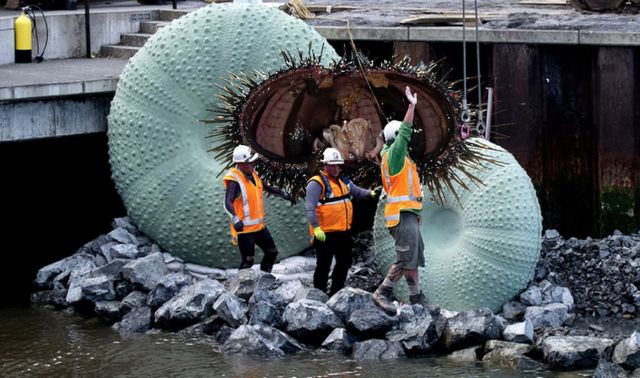
kina
- Eye of the Fish
- Nooooo, you’re doing it all wrong ! Michael Tuffery, esteemed sculptor, visual artist, creator of giant kina nesting on the side of the seabed by the Kumutoto stream – surely you’ve got it all wrong?!
- Accepted from Eye of the Fish feed
- Tagged as:
- sculpture
- waterfront
-
- More...
Related sites
-
-
Ferns; a site specific sculpture by Neil Dawson
- An innovative website created to showcase the Ferns sculpture project and other site specific artworks by Neil Dawson.
- Tagged as:
- sculpture
-
-
-
LeSa Gallery
- Lesa Art Gallery is a new art gallery situated in the historic zone of Jackson Street, Petone. The concept of the gallery is to exhibit artists that are just beginning their careers and are looking to establish themselves professionally. While, also showing more established artists that are yet to exhibit in Wellington.
- Tagged as:
- sculpture
- museums-and-galleries
- petone
-
-
-
Wellington Sculpture Trust
- The trust was established in 1982 to raise funds for Tanya Ashken's Albatross and to commission high quality sculpture for Wellington. It works in partnership with Wellington City Council, Creative New Zealand, other trusts with Wellington links, public a
- Tagged as:
- sculpture
-
-
-
Wellington Writers Walk
- Discover 23 tributes to this city by the sea; amazing typographical sculptures dotted unexpectedly along Wellington's picturesque waterfront.
- Submitted by tonytw1
- Tagged as:
- books
- sculpture
- waterfront
-
-
-
{Suite} Gallery
- Suite Art Gallery has been established to represent New Zealand contemporary artists who feature in significant public and private collections. Suite has two Galleries in Wellington located at Level 2, 147 Cuba Street and 108 Oriental Parade.
- Submitted by anon2911
- Tagged as:
- exhibitions
- photography
- sculpture
- cuba-street
-
Sculpture watchlist
Pages which publish sculpture related newsitems.
-
-
Wellington Sculpture trust news
- Wellington Sculpture Trust
- Last Changed: 1 week ago
- Automatically tagged as:
- sculpture
-
